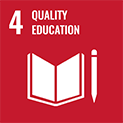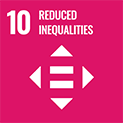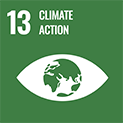2024 to 2025 Departmental Sustainable Development Strategy Report
Table of Contents
- Introduction to the 2024 to 2025 Departmental Sustainable Development Strategy Report
- Commitments for Canadian Institutes of Health Research
- Integrating Sustainable Development
Introduction to the 2024 to 2025 Departmental Sustainable Development Strategy Report

The 2022 to 2026 Federal Sustainable Development Strategy (FSDS) presents the Government of Canada's sustainable development goals and targets, as required by the Federal Sustainable Development Act. This is the first FSDS to be framed using the 17 Sustainable Development Goals (SDGs) of the United Nations 2030 Agenda and provides a balanced view of the environmental, social, and economic dimensions of sustainable development.
In keeping with the purpose of the Act, to make decision-making related to sustainable development more transparent and accountable to Parliament, the Canadian Institutes of Health Research (CIHR) supports the goals laid out in the FSDS through the activities described in CIHR's 2023 to 2027 Departmental Sustainable Development Strategy (DSDS). This Report provides a report on progress related to CIHR's DSDS in the fiscal year 2024 to 2025.
The Federal Sustainable Development Act also sets out seven principles that must be considered in the development of the FSDS as well as DSDSs. These basic principles have been considered and incorporated in CIHR's DSDS and 2024 to 2025 DSDS Report.
To promote coordinated action on sustainable development across the Government of Canada, CIHR's departmental strategy reports on Canada's progress towards implementing the 2030 Agenda and advancing the SDGs, supported by the Global Indicator Framework (GIF) and Canadian Indicator Framework (CIF) targets and indicators. The Report also now captures progress on SDG initiatives that fall outside the scope of the FSDS.
Commitments for Canadian Institutes of Health Research
Goal 4: Promote knowledge and skills for sustainable development
FSDS Context:

In support of this goal to promote knowledge and skills for sustainable development, CIHR invests in health research and training to support the creation of new knowledge and its translation into improved health for Canadians. The Agency has launched several initiatives in recent years with ongoing support for research and training in the environmental and sustainable development sector including:
- Two initiatives have been launched in support of the Government of Canada’s Pan-Canadian Framework on Clean Growth and Climate Change, by funding environments and health research:
- The Food Security and Climate Change in the Canadian North Initiative supports research that will provide a deeper understanding of food security and climate change in the Canadian North, with a focus on Indigenous populations (i.e., First Nations, Inuit, and Métis), and to support the development of effective approaches, programs, and policies to address the issue.
- The Research Network on Lyme Disease funding opportunity established a Network to generate new knowledge to improve the diagnosis and treatment of Lyme Disease in Canada. Given that changing climate and weather patterns affect the emergence and re-emergence of vector-borne diseases, including Lyme disease, the Research Network on Lyme Disease is well-positioned to contribute research evidence related to the health impacts of climate change.
- The Healthy Cities Research Initiative (HCRI) focuses on how urban environments have the potential to become engines of good health and health equity. Governments and communities can harness this potential by promoting physical activities, healthy eating, social connectivity, economic opportunity, and injury prevention as well as access to health services, clean air, nutritious food, and green space. The HCRI has the overarching goal of improving health in Canada by ensuring urban environments are maximizing their health-promoting potential and minimizing their harms. CIHR continues to support HCRI through a series of funding opportunities, grants and fellowships including the Healthy Cities Research Training Platform.
- The Community-Based Research in Climate Change Priority Areas Catalyst Grants support research in climate justice, food security in northern communities, Lyme disease alternate diagnoses, and health impacts of climate change on older adults. In partnership with Public Health Agency of Canada, this funding fosters equitable partnerships between communities affected by climate change and researchers, ensuring that local priorities are addressed while advancing health outcomes.
Implementation Strategy: Support youth skill development in environmental sectors
Departmental Action: Support students at every stage of study, help develop research skills and assist in the training of highly qualified personnel in environmental sectors
-
Programs
- Investigator-Initiated Research
- Training and Career Support
- Research in Priority Areas
-
Performance Indicator/Starting Point/Target
Performance indicator: Number of supported research trainees working on projects related to environment and/or sustainable development. Progress towards target is reported by fiscal years.
Starting point: Baseline based on average of the last three fiscal years of available data (from 2019 to 2022):
- Indirect trainees – 76 per fiscal year
- Direct trainees – 25.7 per fiscal year
Target: Maintain current level through to 2027Footnote *
-
How the departmental action contributes to the FSDS goal and target and, where applicable, to Canada's 2030 Agenda National Strategy and SDGs
This departmental action contributes to FSDS Goal 4 by funding research in health, environment and sustainable development that in turn supports research trainees and students. By preparing young Canadians for success in this high-growth sector, CIHR will contribute to increasing the number of STEM graduates in Canada.
Relevant targets or ambitions:
GIF Target:
- 4.4 By 2030, substantially increase the number of youth and adults who have relevant skills, including technical and vocational skills, for employment, decent jobs and entrepreneurship.
- 4.7 By 2030, ensure that all learners acquire the knowledge and skills needed to promote sustainable development, including, among others, through education for sustainable development and sustainable lifestyles, human rights, gender equality, promotion of a culture of peace and non-violence, global citizenship and appreciation of cultural diversity and of culture's contribution to sustainable development.
-
Results achieved
Indicator result:
Number of supported research trainees: 134
- Indirect Trainees: 83 per fiscal year
- Direct Trainees: 51 per fiscal year
Notes:
- Indirect Trainees results are always for previous fiscal year (e.g. 2023 to 2024 for above) due to the methodology used for collecting and validating this data.
- Breakdown of indirect trainees by type and number (per fiscal year):
- 30 Bachelor
- 22 Masters
- 20 Doctoral
- 11 Postdoctoral
- Breakdown of direct trainees by type and number (per fiscal year):
- 1 Undergraduate
- 14 Masters
- 1 Masters / Doctoral (dual degree program)
- 24 Doctoral
- 11 Postdoctoral
Implementation Strategy: Work with partners on sustainable development research initiatives
Departmental Action: Support team-led research projects on sustainable development
-
Programs
- Investigator-Initiated Research
- Training and Career Support
- Research in Priority Areas
-
Performance Indicator/Starting Point/Target
Performance indicator: Annual number of partners on research projects related to sustainable development.
Starting point: Baseline based on average of the last three fiscal years of available data (from 2019 to 2022):
- 7.7 Partners per fiscal year
Target: Maintain current level through to 2027Footnote *
-
How the departmental action contributes to the FSDS goal and target and, where applicable, to Canada's 2030 Agenda National Strategy and SDGs
This departmental action contributes to the FSDS Goal 4 by supporting environmental research by leveraging Canadian and international research partnerships and funds projects that address identified research gaps. This will in turn support increased research outputs and publications, thus increasing Canada's Average Relative Citation (target).
Relevant targets or ambitions:
GIF Target:
- 4.4 By 2030, substantially increase the number of youth and adults who have relevant skills, including technical and vocational skills, for employment, decent jobs and entrepreneurship.
- 4.7 By 2030, ensure that all learners acquire the knowledge and skills needed to promote sustainable development, including, among others, through education for sustainable development and sustainable lifestyles, human rights, gender equality, promotion of a culture of peace and non-violence, global citizenship and appreciation of cultural diversity and of culture's contribution.
-
Results achieved
Indicator result:
Number of partners: 7
Goal 10: Advance reconciliation with Indigenous Peoples and take action on inequality
FSDS Context:

CIHR supports the Government of Canada’s goal of advancing reconciliation with Indigenous Peoples by removing systemic barriers to accessing research funding and embracing a diversity of perspectives to enhance the participation and retention of outstanding researchers from all under-represented groups. CIHR’s funded researchers exemplify research excellence by contributing to the establishment of modern systems that drive healthcare innovation and transformation. By supporting our scientists, and through our commitment to excellence, CIHR aims at maximizing the impact of research on and for the health and economic prosperity of all Canadians.
CIHR works towards a vision in which Indigenous communities will lead health research by supporting research with and for indigenous communities, focused on resilience, wellness, and Indigenous Ways of Knowing, and resulting in equitable health outcomes. CIHR is committed to working to close gaps in health outcomes, ensuring culturally safe care, and strengthening First Nations-, Métis- and Inuit-led research. This means:
- Investing in Indigenous-led health research through expanded funding programs designed and governed in partnership with Indigenous Peoples.
- Embedding Indigenous governance and review into all CIHR funding processes involving Indigenous data, knowledge, or communities.
- Reporting annually on CIHR’s progress towards goals aligned with the Truth and Reconciliation Commission’s Calls to Action so CIHR’s actions remain transparent and accountable.
Alongside its partners at other research granting councils, CIHR is deepening support for Indigenous self-determination in research. This includes targeted funding to support First Nations, Inuit, and Métis researchers in launching their research faculty careers, and renewing funding for the Network Environments for Indigenous Health Research. To date, efforts like the NEIHRs initiative have supported hundreds of Indigenous researchers and trainees in building research programs rooted in community priorities, and growing this impact in the years ahead will remain a priority.
CIHR is committed to strengthening adjudication of research proposals and the conduct of research by facilitating diversity of expertise, methods and perspectives, as well as international perspective. The Agency has implemented measures such as diverse panel compositions for peer review, and unconscious bias training for peer reviewers to advance this commitment.
CIHR also continues to establish equity, diversity and inclusion in the research system by delivering a variety of initiatives, in close collaboration with Natural Sciences and Engineering Research Council (NSERC) and Social Sciences and Humanities Research Council (SSHRC).
The Tri-Agencies continued to deliver funding, stemming from Budget 2022 to support Black scholars at the undergraduate, masters, doctoral, and postdoctoral and post-health professional degree stages through existing scholarship and fellowship programs. This funding is contributing to strengthening the research capacity of Black scholars and enriching Canadian research and innovation.
In addition, in 2022 CIHR launched the National Women’s Health Research Initiative, a joint partnership with Women and Gender Equality Canada, which is advancing a coordinated research program to address under-researched and high-priority areas of women’s and gender-diverse people’s health and ensures new evidence improves women’s and gender-diverse people’s care and health outcomes.
Implementation Strategy: Implement the United Nations Declaration on the Rights of Indigenous Peoples Act
Departmental Action: Support research training and research into Indigenous health and/or research by Indigenous researchers
-
Programs
- Investigator-Initiated Research
- Training and Career Support
- Research in Priority Areas
-
Performance Indicator/Starting Point/Target
Performance indicator: Percentage of research investments in grants and awards addressing Indigenous health.
Starting point: 4.6% as of 2016
Target: Greater than or equal to 4.6% of CIHR's total annual Grants and Awards expenditures by 2027
-
How the departmental action contributes to the FSDS goal and target and, where applicable, to Canada's 2030 Agenda National Strategy and SDGs
This departmental action contributes to FSDS Goal 10 by supporting Indigenous communities to lead health research founded in Indigenous ways of knowing focused on resilience and wellness, and by establishing research environments that are socially spiritually, emotionally and physically safe for Indigenous Peoples as rights-holders.
Relevant targets or ambitions:
GIF Target:
- 10.3 Ensure equal opportunity and reduce inequalities of outcome, including by eliminating discriminatory laws, policies and practices and promoting appropriate legislation, policies and action in this regard.
-
Results achieved
Indicator result:
Percentage of research investments in grants and awards addressing Indigenous health: 4.7%
Implementation strategies supporting the goal
This section is for implementation strategies that support the goal "Advance reconciliation with Indigenous Peoples and take action on inequality" but not a specific FSDS target.
Implementation Strategy: Invest in targeted scholarships
Departmental Action: Implement programming designed to benefit scholars from underrepresented groups
-
Program
- Investigator-Initiated Research
- Training and Career Support
- Research in Priority Areas
-
Performance Indicator/Starting Point/Target
Performance indicators:
- Percentage of newly funded recipients who self-identify as women
- Percentage of newly funded recipients who self-identify as visible minorities
- Percentage of newly funded recipients who self-identify as Indigenous Peoples
- Percentage of newly funded recipients who self-identify as persons with disabilities
Starting point (in 2022–2023):
- Percentage of newly funded recipients who self-identify as women – 45.2%
- Percentage of newly funded recipients who self-identify as visible minorities – 23.9%
- Percentage of newly funded recipients who self-identify as Indigenous Peoples – 1.3%
- Percentage of newly funded recipients who self-identify as persons with disabilities – 2.9%
Target (by 2027):
- Percentage of newly funded recipients who self-identify as women – 51.2%
- Percentage of newly funded recipients who self-identify as visible minorities – 29.1%
- Percentage of newly funded recipients who self-identify as Indigenous Peoples – 1.4%
- Percentage of newly funded recipients who self-identify as persons with disabilities – 3.6%
-
How the departmental action contributes to the FSDS goal and target and, where applicable, to Canada's 2030 Agenda National Strategy and SDGs
CIHR implements a variety of programs designed to contribute to the organization's equity, diversity and inclusion commitments, including the Research Excellence, Diversity and Independence (REDI) Early Career Transition Award, funding to support Black scholars, and support for early career researchers, women, Indigenous Health research and French applications as part of the Project Grant Program.
Relevant targets or ambitions:
GIF Target:
- 10.2 By 2030, empower and promote the social, economic and political inclusion of all, irrespective of age, sex, disability, race, ethnicity, origin, religion or economic or other status.
- 10.3 Ensure equal opportunity and reduce inequalities of outcome, including by eliminating discriminatory laws, policies and practices and promoting appropriate legislation, policies and action in this regard.
-
Results achieved
Indicator result:
- Percentage of newly funded recipients who self-identify as women – 51.1%
- Percentage of newly funded recipients who self-identify as visible minoritiesFootnote 1 – 28.9%
- Percentage of newly funded recipients who self-identify as Indigenous Peoples – 2.5%
- Percentage of newly funded recipients who self-identify as persons with disabilities – 7.2%
Goal 12: Reduce waste and transition to zero-emission vehicles
FSDS Context:

CIHR is supporting the Government of Canada's goal and the net-zero procurement target. CIHR is also supporting the goal of waste diversion targets by integrating environmental considerations into procurement management processes and controls, motivating suppliers to reduce the environmental impact of the goods and services they deliver and their supply chains, and ensuring that decision-makers, material management and procurement specialists have the necessary training and awareness to support green procurement.
Implementation Strategy: Strengthen green procurement criteria
Departmental Action: Integrated environmental considerations into the procurement process
-
Program
Internal Services
-
Performance Indicator/Starting Point/Target
Performance indicator: Percentage of purchases that include provisions to reduce the environmental impact of procurement activities.
Starting point: New program.
Target: By 2026, 100% of our tenders will include provisions to reduce the environmental impact of procurement activities.
-
How the departmental action contributes to the FSDS goal and target and, where applicable, to Canada's 2030 Agenda National Strategy and SDGs
This departmental action contributes to the FSDS Goal 12 by supporting the promotion of public procurement practices that are aimed at reducing environmental impact, in accordance with national policies and priorities thus improving Canada's waste diversion targets.
Relevant targets or ambitions:
GIF targets:
- 12.7 Promote public procurement practices that are sustainable, in accordance with national policies and priorities.
-
Results achieved
Indicator result:
Percentage of purchases that include provisions to reduce the environmental impact of procurement activities: 90%.
Departmental Action: Procurement specialists complete training on green procurement
-
Program
Internal Services
-
Performance Indicator/Starting Point/Target
Performance indicator: Percentage of procurement specialists that have completed green procurement training.
Starting point: 57% (4 procurement specialists) in 2023
Target: 100% (7 procurement specialists) by 2024
-
How the departmental action contributes to the FSDS goal and target and, where applicable, to Canada's 2030 Agenda National Strategy and SDGs
This departmental action increases knowledge of sustainable procurement practices among CIHR procurement officers.
Relevant targets or ambitions:
GIF targets:
- 12.7 Promote public procurement practices that are sustainable, in accordance with national policies and priorities.
-
Results achieved
Indicator result:
Percentage of procurement specialists that have completed green procurement training: 100% maintained
Goal 13: Take action on climate change and its impacts
FSDS Context:

The Government of Canada recognizes that climate change affects the health of Canadians, especially the most at-risk populations such as youth, seniors, Indigenous populations, those with chronic health conditions, and equity-seeking groups. CIHR contributes to moving this goal forward through different funding initiatives such as the government's Pan-Canadian Framework on Clean Growth and Climate Change. Through this initiative, CIHR has implemented targeted investments in health and climate change. Operationally, CIHR is adopting innovative practices in line with the Government of Canada's Greening Government Strategy and its commitment to greener operations to achieve net-zero emissions and become climate-resilient. Through these measures, CIHR supports the Government of Canada's commitment to reduce GHG emissions by 2050 and ensure our processes, policies and programs reflect this commitment to the environment.
CIHR and its workforce are adopting a future workplace model that is flexible to balance organizational excellence and the wellness of our employees. With the opportunity to reimagine our work, CIHR has chosen a hybrid work model. Through this model, CIHR's workforce is embracing a modern, sustainable work culture that will allow for effective virtual core business as well as in-person collaborations. This is a work environment that is both socially and environmentally sustainable and is committed to more responsible business practices that reduce our carbon footprint and better steward our environment. Workforce innovations that encourage positive environmental practices include the implementation of the CIHR cloud strategy, migrating its application portfolio from its on-premises data centre to the cloud. In addition, CIHR is enhancing the use of virtual meeting and training spaces, continuing to offset the need for in-person and associated travel, that ultimately reduces negative environmental effects of its activities.
CIHR will be moving its office in 2025 in conjunction with the end of its current lease. Our workspace will be designed as per the Government of Canada Workplace standards, based on the seven dimensions of creating a flexible, healthy, efficient, inclusive, collaborative, green and technologically advanced digital space. The new location, which is compliant with accessibility standards, has received the Leadership in Energy and Environmental Design (LEED) Gold certification and is centrally located allowing employees to use public transportation. Onsite bike cages and showers encourage active transportation.
The hybrid model also allows CIHR to decrease office space, eliminate surplus items, and therefore reduce greenhouse gas emissions. In preparation for the move, CIHR has been recycling several tons of paper and actively participating in local waste diversion programs to responsibly dispose of surplus items while successfully diverting waste from landfills. This action, along with CIHR's other innovations, will increase the Agency's resilience of operations to the impacts of climate change.
Implementation Strategy: Implement the Greening Government Strategy through measures that reduce greenhouse gas emissions, improve climate resilience, and green the government's overall operations
Departmental Action: Eliminate physical recordsFootnote ** and offsite storage footprint through digitization, while adhering to responsible recycling and disposal methods
-
Program
Internal Services
-
Performance Indicator/Starting Point/Target
Performance indicator: Percentage of physical records digitized and disposed of.
Starting point: 62% of physical records digitized and disposed of in 2022–2023
Target: 100% of physical records digitized and disposed of by 2027
-
How the departmental action contributes to the FSDS goal and target and, where applicable, to Canada's 2030 Agenda National Strategy and SDGs
This departmental action contributes to the FSDS Goal 13 by integrating measures to reduce paper consumption while eliminating storage footprint of physical records, and increasing the resilience of operations to impacts of climate change.
Relevant targets or ambitions:
CIF Ambition/Target: 13.1 Canadians reduce their greenhouse gas emissions.
CIF Indicator: 13.1.1 Greenhouse gas emissions
GIF Target: 13.2 Integrate climate change measures into national policies, strategies and planning
-
Results achieved
Indicator result:
Pereentage of physical recordsFootnote ** digitized and/or disposed of: 81%.
Notes:
Digitization and destruction of paper records on hold due to upcoming office relocation. Activities to resume in October 2025. Still on target to have 100% of all physical records digitized and/or disposed of by 2027. Only records under litigation hold will not be digitized and/or disposed.
Integrating Sustainable Development

CIHR will continue to ensure that its decision-making process includes consideration of FSDS goals and targets through its Strategic Environmental and Economic Assessment (SEEA) process. A SEEA for a policy, program or regulatory proposal includes an analysis of the climate, nature, environmental and economic effects of the given proposal.
Public statements on the results of CIHR’s assessments are issued when an initiative that was the subject of a detailed Strategic Environmental and Economic Assessment is implemented or announced on the CIHR Publications web page. The purpose of the public statement is to demonstrate that the environmental and economic effects, including contributions to the FSDS goals and targets, of an initiative have been considered during proposal development and decision making.
CIHR issued two public statements for proposals that were subject to a detailed SEEA in 2024 to 2025.
- Date modified: